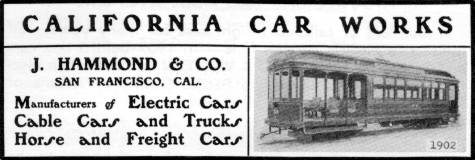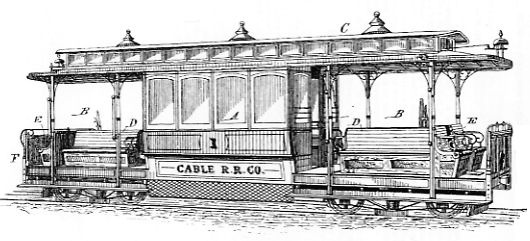J. Hammond & CompanyCalifornia Car Works
|
 |
The shops of the California Car Works were located at different places over the years, including addresses on Beale, Fremont, Folsom, Market and Townsend streets.
In the 1883 San Francisco directory, the J. Hammond Car Company (associated with W.L. Holman) is listed at 217-227 Fremont Street and 334 Beal Street. {302}
In 1887 and in 1892, when they were destroyed by fire, the works were located on Fremont Street, between Folsom and Howard Streets in a two-story frame building adjacent to the Fulton Iron Works. Both buildings extended through the block to Beale Street. Their losses in 1887 were estimated at somewhere between $40,000 and $50,000, and in 1892, at $80,000. [The lesson to be learned, that foundries with their fires and car bodies made of wood don’t go well together, a lesson learned sooner or later by almost every car builder!]
By 1892, the firm was doing business as John Hammond & Sons. [And was apparently no longer associated with W.L. Holman.] In the 1894 city directory, Holman was listed at 230 Fremont Street. {302}
In 1906, at the time of the great earthquake, the shops of the California Car Works were on King Street, just outside the area of the fire. On April 30, 1906, Hammond advertised, “We have escaped the fire and are ready to operate.”
John Hammond’s son Manton E. Hammond became the firm’s bookkeeper in 1893 and became Superintendent of the works sometime before June of 1900. He became owner of the firm as well upon his father’s death in 1901. It was probably shortly after John Hammond’s death that the firm name became J. Hammond & Company, as in the above advertisement.
Hammond, like so many others, began by building horse-powered street cars. The body of one, built in 1887 for the Oakland Railroad, a South Pacific Coast subsidiary, is owned by the Society for the Preservation of Carter Railroad Resources.
 |
|
Illustration from Hammond’s 1891 design patent. |
The company had a reputation for quality cars that included using more iron than other builders. The first 50 of these cars were destroyed in the fires that followed the 1906 earthquake. A 1907 advertisement says “Our specialty is cars for the Pacific Coast, and it might be noted in that connection that we were the originators and patentees of what has become the standard car for California—the double end California Car. Cars may be personally inspected during course of construction. This will appeal particularly to Companies on the Pacific Coast. We build trucks, too—good trucks. Let us estimate your work.” (Offices 7th and King St.)
Reading the preceding paragraphs, one might get the impression Hammond built only cable cars. But such was not the case, they also built electric streetcars and cars for steam railroads. However, their production was mainly limited to California, with many Hammond cars going to the Sacramento area, San Francisco and the Los Angeles area. Pacific Electric was one of their major customers, buying large double-truck cars for interurban service. Portland also had several Hammond cars.
It is hard to find Hammond cars built for steam railroads. Virtually all went to lines in California and Nevada.
Hammond was also an early builder of elevators. The legal findings of Board of Trade vs. Hammond Elevator Co., 198 U.S. 424, 437-38 (1905), having to do with the nature of employee relationships, seems to be widely cited.
Manton Hammond continued to build railroad cars and elevators until 1910 when he apparently closed the business to explore other opportunities. {29}
Cast of Characters —
John Hammond (1831-1901) was born in Massachusetts, and apparently came to California sometime between 1869 and 1872. He appears to have had a background as a millwright, a mechanic that constructs and maintains machines to manufacture other machines or products. We don’t yet know how or why he came to California, nor why or how he came to enter the car building business. If you can help us with this information, please share it with us.
Manton E. Hammond (1872-1920+) was born in California. He became bookkeeper for his father’s firm at the age of 21. He became superintendent of the works sometime before 1900, and inherited the business upon his father’s death in 1901. The Earthquake and accompanying fire of 1906 presented a challenge to keeping the firm in business, and Manton closed it down about 1910. The 1910 census shows him living in the San Francisco area, with occupation listed as salesman of building supplies. The 1920 census shows him still in San Francisco, with occupation listed as manufacturer’s agent.